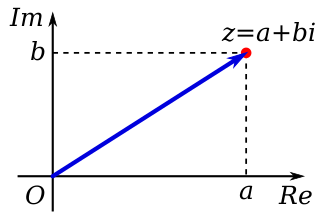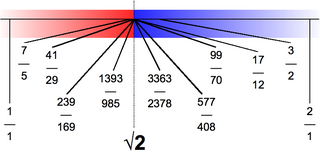
An algebraic number is a number that is a root of a non-zero polynomial in one variable with integer coefficients. For example, the golden ratio, , is an algebraic number, because it is a root of the polynomial x2 − x − 1. That is, it is a value for x for which the polynomial evaluates to zero. As another example, the complex number is algebraic because it is a root of x4 + 4.

In mathematics, a complex number is an element of a number system that extends the real numbers with a specific element denoted i, called the imaginary unit and satisfying the equation ; every complex number can be expressed in the form , where a and b are real numbers. Because no real number satisfies the above equation, i was called an imaginary number by René Descartes. For the complex number ,a is called the real part, and b is called the imaginary part. The set of complex numbers is denoted by either of the symbols or C. Despite the historical nomenclature, "imaginary" complex numbers have a mathematical existence as firm as that of the real numbers, and they are fundamental tools in the scientific description of the natural world.
In mathematics, a transcendental number is a real or complex number that is not algebraic: that is, not the root of a non-zero polynomial with integer coefficients. The best-known transcendental numbers are π and e. The quality of a number being transcendental is called transcendence.
In number theory, a Liouville number is a real number with the property that, for every positive integer , there exists a pair of integers with such that
In mathematics, a transcendental extension is a field extension such that there exists an element in the field that is transcendental over the field ; that is, an element that is not a root of any univariate polynomial with coefficients in . In other words, a transcendental extension is a field extension that is not algebraic. For example, and are both transcendental extensions of
In abstract algebra, a subset of a field is algebraically independent over a subfield if the elements of do not satisfy any non-trivial polynomial equation with coefficients in .
In mathematics, a transcendental function is an analytic function that does not satisfy a polynomial equation whose coefficients are functions of the independent variable that can be written using only the basic operations of addition, subtraction, multiplication, and division. This is in contrast to an algebraic function.

In transcendental number theory, the Lindemann–Weierstrass theorem is a result that is very useful in establishing the transcendence of numbers. It states the following:
In mathematics, complex multiplication (CM) is the theory of elliptic curves E that have an endomorphism ring larger than the integers. Put another way, it contains the theory of elliptic functions with extra symmetries, such as are visible when the period lattice is the Gaussian integer lattice or Eisenstein integer lattice.
In mathematics, the Gelfond–Schneider theorem establishes the transcendence of a large class of numbers.
In mathematics, Roth's theorem or Thue–Siegel–Roth theorem is a fundamental result in diophantine approximation to algebraic numbers. It is of a qualitative type, stating that algebraic numbers cannot have many rational approximations that are 'very good'. Over half a century, the meaning of very good here was refined by a number of mathematicians, starting with Joseph Liouville in 1844 and continuing with work of Axel Thue, Carl Ludwig Siegel, Freeman Dyson, and Klaus Roth.
In mathematics, the exponential of pieπ, also called Gelfond's constant, is the real number e raised to the power π.

In mathematics, specifically transcendental number theory, Schanuel's conjecture is a conjecture about the transcendence degree of certain field extensions of the rational numbers , which would establish the transcendence of a large class of numbers, for which this is currently unknown. It is due to Stephen Schanuel and was published by Serge Lang in 1966.

In mathematics, an irrationality measure of a real number is a measure of how "closely" it can be approximated by rationals.

In mathematics, specifically algebraic geometry, a period or algebraic period is a complex number that can be expressed as an integral of an algebraic function over an algebraic domain. The periods are a class of numbers which includes, alongside the algebraic numbers, many well known mathematical constants such as the number π. Sums and products of periods remain periods, such that the periods form a ring.
In mathematics, E-functions are a type of power series that satisfy particular arithmetic conditions on the coefficients. They are of interest in transcendental number theory, and are closely related to G-functions.
In mathematics, auxiliary functions are an important construction in transcendental number theory. They are functions that appear in most proofs in this area of mathematics and that have specific, desirable properties, such as taking the value zero for many arguments, or having a zero of high order at some point.
In mathematics, specifically the field of transcendental number theory, the four exponentials conjecture is a conjecture which, given the right conditions on the exponents, would guarantee the transcendence of at least one of four exponentials. The conjecture, along with two related, stronger conjectures, is at the top of a hierarchy of conjectures and theorems concerning the arithmetic nature of a certain number of values of the exponential function.

In mathematics, the irrational numbers are all the real numbers that are not rational numbers. That is, irrational numbers cannot be expressed as the ratio of two integers. When the ratio of lengths of two line segments is an irrational number, the line segments are also described as being incommensurable, meaning that they share no "measure" in common, that is, there is no length, no matter how short, that could be used to express the lengths of both of the two given segments as integer multiples of itself.
In transcendental number theory, a mathematical discipline, Baker's theorem gives a lower bound for the absolute value of linear combinations of logarithms of algebraic numbers. Nearly fifteen years earlier, Alexander Gelfond had considered the problem with only integer coefficients to be of "extraordinarily great significance". The result, proved by Alan Baker, subsumed many earlier results in transcendental number theory. Baker used this to prove the transcendence of many numbers, to derive effective bounds for the solutions of some Diophantine equations, and to solve the class number problem of finding all imaginary quadratic fields with class number 1.



































